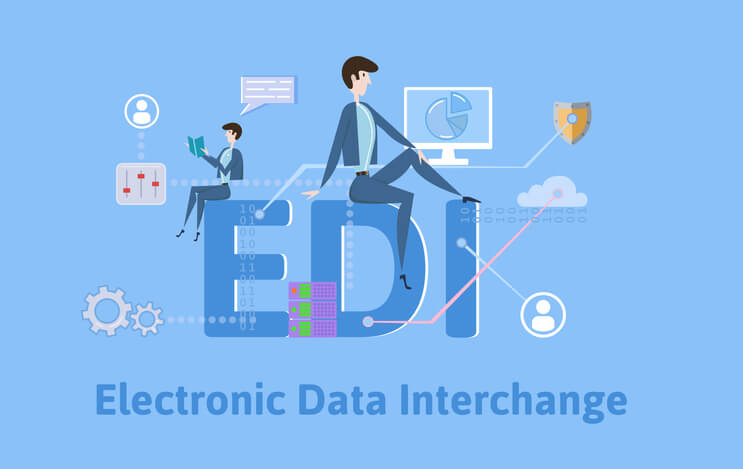How EDI Streamlines Supply Chain
by Roberto Mangual | December 9, 2019

The fashion and home goods industries operate global supply chains that must move quickly to deliver on trend products at the speed of consumer demand. Electronic Data Interchange, or EDI, enables two companies to exchange information instantly about orders, payments, inventory, shipments, production orders, and more.
In today’s global business world, EDI has gone from a nice-to-have to a must-have tool for facilitating rapid commerce. The benefits of using EDI in your business are many, and include:
• Improved order accuracy
• Reduced order processing times
• Increased global supply chain visibility
• Greater operational efficiency
• Faster communication with vendors and customers
EDI Keeps Global Supply Chain Data Flowing
EDI enhances information exchange between apparel and home goods brands and their suppliers, wholesalers, retailers, third-party manufacturers (3PM) and third-party logistics providers (3PL). Brands gain excellent visibility into the status of Work in Progress (WIP) and order fulfillment as each new job or order works its way through the global supply chain.
EDI helps rapidly growing businesses scale more quickly, without becoming bogged down waiting for information. Everything can be automated and scheduled, so your employees no longer need to prepare information and transmit it manually to supply chain partners.
Only EDI can ensure that you are sending and receiving up-to-the-minute information about orders and fulfillment with your trading partners. Customers place orders and you receive the data instantly. Likewise, if you need to place new production orders to 3PMs halfway around the world, they will have the information needed to get to work ASAP. Your warehouse or 3PL will receive the information about shipments arriving from manufacturing or shipments that need to be picked and shipped to retailers.
EDI Increases Order Accuracy and Speeds Fulfillment
With EDI, it’s easy to receive thousands of purchase orders per day and process them in minutes. You can create a catalog with item numbers, price list, sizes and options that customers can receive instantly, at any time, and use to create accurate orders.
EDI can help reduce payment risk and improve cash flow. When an order comes in, EDI can automatically request confirmation of the customer’s credit line with their Factor [ex., Wells Fargo or other institutions]. When orders are filled and shipped, EDI can automatically send invoices to the Factor and the customer.
Manual data entry is prone to error. When your EDI is built into your ERP system, the information flows seamlessly without the possibility of typographical errors that arise when your employees have to rekey data into a separate system.
Improved Visibility Strengthens Customer Relationships
With EDI, brands enjoy unsurpassed visibility into the status of production, inventory, logistics, and order processing. No more having to send employees to Asia or South America to iron out the status of work in progress. No more wondering if you’ll be able to fulfill your biggest orders.
With EDI, you can stay on top of every production order, shipment and sale. And you can extend that enhanced visibility to your customers. Without hiring more employees or spending extra time creating reports, you will be able to deliver better informed customer service that strengthens long-term business relationships.
EDI Opens New Sales Opportunities
Strong relationships with smaller customers may still be built on relationships alone. But without the proper systems in place to provide efficiency and visibility, larger customers simply cannot do business with fashion and home goods brands. Brands that leverage EDI position themselves to do business with the world’s largest retailers and e-commerce platforms, many of whom require EDI as their standard for information exchange. Getting your products into a giant retailer like Walmart, Target or Macy’s can generate business-transforming sales volume and revenue potential.
Exenta ERP Delivers Built-in EDI
If modernizing your business with EDI sounds intimidating—you can relax with Exenta EDI. Part of our next-generation Exenta ERP, everything you need for flawless EDI is built in to the system. Our EDI was designed to be extremely easy use—once you set it up, it works every time. Our technology takes care of data file translation and transmission behind the scenes. No matter the complexity, Exenta EDI puts the information you need at your fingertips.
Every task is completed in once place—no need to go into multiple systems to set up new trading partners. There is no third-party translator to cause technical glitches. Our Customer Support team walks each customer through the process of setting up their first trading partner from start to finish.
Exenta EDI can be a game-changer for brands seeking greater visibility and more sophisticated trading partners. Exenta ERP also provides seamless data handling across multiple channels, including pre-built integration into e-commerce heavyweights such as Shopify, Magento, and Amazon. Schedule an Exenta ERP demo today and ask to see how easy it is to streamline your supply chain with EDI.
Having an advanced EDI system helps your company stay up to date with trends and keep up with customer demand. Learn more about how Exenta’s EDI system can benefit your supply chain.



